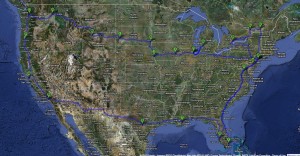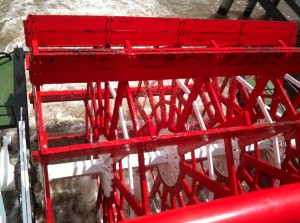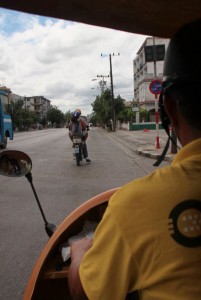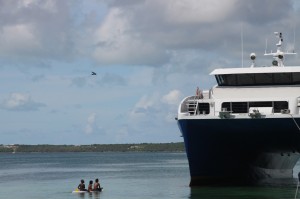climate change, fuel, society, travel, USA
4 tuktuks, 3 airplanes and a Mississippi steamboat – my Carbon Footprint in 2010
15 Jan 2011I’ve done a lot of travelling in 2010. Namely across the Atlantic, looping around the USA, into the Caribbean and travelling down Central America as far as Nicaragua. So naturally I’m concerned about what the cost is to our shared natural environment of all my wanderings. From the outset I’ve tried to travel as environmentally friendly as possible, which informed my decision to travel across the Atlantic by ship
Even so, my travelling must have had a big impact on the environment that we all have a stake in, and over the New Year I’ve been trying to figure out to my satisfaction what that might be, and how good an idea (for everybody else and our shared global environment) me travelling around having a good time is.
To give you an idea of why I think this is important, have a look at my recent article that details how the world’s politicians have failed us when it comes to combatting climate change, and how we are, unfortunately to say the least, heading for an all-out global catastrophe.
I’ve worked out a very approximate answer in terms of a “carbon footprint”, measured in metric tonnes of carbon dioxide (* see note 1).
But rather than first list a bunch of figures I want to look back on exactly how far I’ve come, compare that to my “carbon budget”, and consider the choices I made and what I got out of it.
I arrived in New York City at the beginning of January on a ship from Southampton, England. After visiting Philadelphia, Boston, Washington D.C., Toronto, Ottawa and Montreal by long-distance bus and train, in April I moved to Chicago (by train) and spent 3 nice weeks there. I then hired a car (a hybrid electric Toyota Prius) and drove 5000 miles across the West through Seattle and down through Portland and Eugene to San Francisco, where I left the car.
I then got a train to L.A., took a campervan around wine country for a few days, and then took a 3-night train ride to New Orleans (these are big distances…). I then took bus and car (with my parents) to Florida, and then finally visited New York City by train again very briefly for the 4th of July before returning by train to Florida. Up against my visa time limit, I flew out of the country to Nassau, The Bahamas, where I stayed for a month and a half. I then flew (there is no other option) to Cuba, and then from Cuba to Cancun (the closest exit). I only took buses after that.
Just taking the carbon cost of the first 6 months in the USA, the obvious big costs are the ship to the Americas, the private car road-trip across the West, the campervan (surprisingly bad) and the flight out of the country. The ship accounts for a huge 1816.1kg of CO2 (nearly two tonnes… although I calculated at the time, marginally less than a transatlantic flight (* see note 2).
The car was the next biggest carbon cost, causing 888kg of CO2 to be released to the atmosphere, contributing to dangerous global climate change. A hybrid-electric car was of course a good choice, and the same journey in an average US car would have created over double the amount of carbon dioxide (1700kg). 888kg of CO2 is a lot to emit in just a month. The global average carbon footprint is “only” 4 tonnes of CO2, so my little road trip created nearly the same amount of CO2 by itself as the average world citizen creates in 4 months from everything they do. By world standards, such a roadtrip is selfish and indulgent. Especially since a sustainable level for each person to emit would be about 2 tonnes. But then that road trip is nothing compared to frequent flying, which I’ll get to in a moment…. The campervan, even though for only 500 miles and several days, with its lower mpg was responsible for 110kg of CO2 (and that’s sharing the cost between my friend and me).
The short flights I took (each less than 350 miles, and one by lower-altitude propeller plane) were actually of relatively small impact, even measuring them using the most rigorous test I could find, the one provided by WWF: https://climatefriendly.com/flight
They created approximately 0.2, 0.2 and 0.1 tonnes of CO2e respectively.
So really, apart from getting across the Atlantic in the first place, my big splurge which most damaged our shared environment was the car, at nearly a tonne of CO2 for a month-long road trip. But at this stage I want to defend the (hybrid) car in relation to the alternative of flying. I “spent” a lot of our shared natural capital on that trip, and a significant proportion of my “fair” yearly share. But I did get a lot out of it. For starters I got to see not just the start and the destination, as in a plane, but all the places along the way: Illinois, Iowa, South Dakota, Nebraska, Wyoming, Montana, Idaho, Washington state, Oregon and California. I visited abandoned Amana colonies, original prairie, the Badlands, Mount Rushmore, Yellowstone Park, Puget Sound, Crater Lake and drove down winding Lombard Street in San Francisco.

My Toyota Prius in the Badlands of South Dakota
I met queer poets, Amish travellers, cowgirls and fightclubbers. Just to highlight how bad flights are, if I had flown from NY to San Francisco it would have been at least 1 tonne of CO2 just in one day. If I had then flown straight to Nassau then that would have added another 2.5 tonnes of CO2. If I’d also flown from London to NY (1.3 to 1.9 tonnes) then I would have used up more CO2 than the average world citizen uses in one year, just on those three flights. It would have been quick. But I would have seen nothing in between, and felt no benefit from it.
Of course, our patterns of year-long-work and 2-weeks-holiday prompt many people to travel this way. But that doesn’t mean it’s a good idea. A consumer economy run for the benefit of the super-rich does many things that aren’t a good idea.
You might have spotted that I haven’t accounted yet for the bus and train travel I did, which is how I did get from San Francisco to Florida. I could attempt to do that, but I’m not going to for a very simple reason: trains and buses are the kind of public transport we should be encouraging people to use, and hoping they do, as alternatives to flights and the private car. At this stage you could accuse me of double standards for pulling the old “but I don’t need to count it because the train/plane/bus would have gone without me on it anyway!” argument. And for the record, I think that argument sucks. Here’s why: yes, the plane would have gone without you on it, but if 300 other people out of the millions that fly each year are making the same choice to not fly, then there would certainly be one less plane in the sky. In this way individual action really clearly does matter, because, even if unseen, individual action can be collective action; we just need some imagination to see that it is. So individuals choosing to not use a certain form of transport does morally credit them, and conversely, choosing to fly does mean that you are responsible for your portion of that pollution. There’s no way of wriggling out of your moral responsibility by blaming the system. So, am I responsible for a portion of the pollution of the buses and trains that I got? Yes of course. But since I want the buses and trains to go, I’m happy to be a part of that. I’m not going to blame myself for being a (practically very-hard-to-measure) small part of a more sustainable world of transport. When all’s said and done, I’m compiling a carbon footprint to find out how damaging the damaging aspects of my travel are, not to arrive at a perfect theoretical figure that makes me feel worse about the good bits. Besides, we do know that buses and trains generally use at least a fifth of the energy of a passenger airplane for the same distance (http://www.withouthotair.com), and without the additional damaging effects of releasing greenhouse gases at altitude. We can therefore be sure that however impactful my bus and train travel, it has been many times less bad than if I had flown those distances. I’m therefore happy to not try to count it.
So, for what it’s worth, the carbon cost of my private travel in 2010 was 3259kg. For a year where I’ve done an awful lot, and theoretically haven’t been responsible for the emissions of government services in the UK, I think that’s pretty good going, considering that when I last estimated my carbon footprint in the UK a couple of years ago I got answers ranging from 2.56 tonnes to 5.31 tonnes and 5.47 tonnes, depending on which website I asked (including http://footprint.wwf.org.uk, Direct Gov, and www.carbonfootprint.com; I think it’s almost certainly the higher numbers). Given that the global average is 4 tonnes, the UK average is 10 tonnes, the industrial country average is 11 tonnes, and the US average is 18 tonnes, I reckon I’m not doing too badly.
Of course my travel figure doesn’t include electricity and heating that I’ve used (practically impossible to find a figure for, given the different places and environments I’ve stayed in). But at least I haven’t bought very many consumer goods or clothes in 2010! And my food footprint remains far lower than average due to my being vegetarian.
The main thing this shows me – with relief – is that it is possible to do a large amount of travelling and not trash the planet. I could have done much better if I’d hitchhiked, or even cycled, across the West. But never of those seemed very practical at the time. More realistically, taking train and bus rather than splurging on the car would have been much better for the environment. And if I’d managed to find a freighter across the Atlantic then that would have saved a whopping two tonnes (I couldn’t find one, and they are generally, strangely, extremely expensive).
Even though I have clearly exceeded what should be my – and your – target limit of about 2 tonnes of CO2 per year, I can feel better about two things: firstly, I had always planned for 2010 to be an exceptional year and I’ve built up some credit through other years of walking and cycling to work and being vegan, and secondly, that you, I, and pretty much everybody else in the industrialised world, is in the same boat. In the US even homeless people cannot drop below a floor of 8.5 tonnes of CO2 per year, to account for their theoretical share of America’s energy-intensive government services (including its ridiculously huge military (bigger than all the other military forces of the world combined…).
All in all, I’m relatively happy that I’m not a first-class climate criminal. My modes of transport have certainly been quite diverse. At last count, this was the whole list… It’s been a fun year:
– – –
footnotes:
*1 (or strictly speaking “carbon dioxide equivalent” (which translates other Greenhouse Gases onto a par with CO2, for sake of examination).
*2 That figure is debateable however, firstly because I had to arrive at the figure of 1.8 tonnes myself (websites don’t tend to offer a calculator for ships) and because one of the websites I now trust most (https://climatefriendly.com/flight) gives a figure of 1.3 tonnes of CO2 equvialent for a London to NY flight, not 1.9 tonnes. It is clear however that sites such as http://www.jpmorganclimatecare.com (which gives a figure of 0.77 tonnes) are underestimating the carbon impact, partly by failing to take into account the effect of “radiative forcing” that I mention in my article about the ship.
 Email This Post
Email This Post
15 Jan 2011 Matt Wootton



